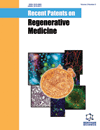Recent Patents on Regenerative Medicine - Volume 4, Issue 2, 2014
Volume 4, Issue 2, 2014
-
-
Advances in Cancer Stem Cell Therapy: Targets and Treatments
More LessAuthors: Keerthana Srinivasan and Biswa P. ChatterjiCancer stem cells (CSCs), a highly clonogenic subpopulation of tumour cells are held to be one of the biggest causes of cancer relapse, metastasis and subsequent mortality. The increasing emergence of evidence in support of the CSC hypothesis has had dramatic implications on our understanding of disease progression and it also offers us the opportunity to develop novel therapeutics that specifically target and eradicate these CSCs. Monoclonal antibodies, small molecule inhibitors, siRNAs and miRNAs are some of the most important molecules in this category. Many of these agents have the ability to either preferentially seek out and kill the CSCs in a tumour based on their biomarker profiles, gene expression signatures and active signalling pathways or to bypass the CSCs’ resistance mechanisms and thus prove more effective as compared to traditional chemotherapy. This review aims to provide an overview of the recent developments in the field of anti-CSC therapeutics, embodied in the form of patent documents. Patents from WIPO, USPTO, Patentscope and European patent databases have been consulted; and the current trend and the sheer number of patents and clinical trials suggests that CSC-specific therapeutics hold great promise for the future of disease management.
-
-
-
Recent Patents on Nanoceramics and Bone Regeneration and Repair
More LessAuthors: Rosemary Dziak, Laura Barres and Sebastiano AndreanaRegeneration of bone lost through pathological and/or traumatic events is a complex process due to the intricate, dynamic nature of the skeleton. Although osseous tissue has the ability in many circumstances to organize its own regeneration, tissue engineering, particularly of large, critical size defects, can be optimized by clinical intervention. Products have been developed to aid in the repair and regeneration of bone based on ever growing knowledge of the interactions of bone cells with the extracellular matrix and mineral components. A number of recent patents have disclosed information regarding the fabrication of nanostructured scaffolds that have the ability to support osteoconduction and how these structures can be utilized in various bone regenerative aspects. Nanoceramics are central to the development of bone tissue-engineered and recent patents address how nanohydroxyapatite, nanocalcium sulfate and other nanomaterials can be utilized alone or as composites in combination with matrix-like polymers, angiogenic and growth factors as well as cells to construct biocompatible implant materials to enhance bone growth.
-
-
-
Periodontal Regenerative Materials and Their Applications: Mechanisms of Action
More LessAuthors: Una El-Shinnawi and Mena SooryBarrier membrane technology, gene delivery and stimulatory proteins for cell growth and metabolism are potential methods for enhancing periodontal regeneration. Factors that contribute to growth and differentiation of connective tissue and bone regulate diverse cells of periodontal origin. Although these agents have significant appeal in promoting periodontal wound healing and bone regeneration, the outcome of current methods may be attenuated in an inflammatory environment. Focused generation of required components for periodontal regeneration is a challenge in the context of molecular redundancy associated with multiple isoforms. Epithelial / mesenchymal tissue interactions are closely modulated by several pleiotropic actions of soluble molecular signals in mineralized and non-mineralized tissues. Significant advances in regenerative tissue engineering rely on fine tuning of activity profiles of redundant isoforms of human osteogenic proteins towards more streamlined activity. Accurate dissemination of active agents to connective tissue and bone, underscores regenerative procedures. Targeted therapy comprising slow release devices, loaded scaffolds, fillers and vehicular microcapsules, delivers stimulatory agents over critical temporal phases of wound healing. Techniques for tissue engineering and gene therapy enhance expansion of cell populations and protein expression. Applications for growth stimulatory factors delivered via barriers, scaffolds, cell sheets and other variants have been addressed alongside recent patents in this context; which pave the way for future applications with more consistent outcome in the human subject.
-
-
-
Experimental Developments and Review of Recent Patents for the Repair of Skeletal Muscles by Methods of Regenerative Medicine
More LessStimulation of damaged muscle tissue regeneration and repair of functional skeletal muscle by methods of regenerative medicine (cell and tissue therapy, tissue engineering) are topical problems of today. Efforts of scientists and physicians are focused on the developments for identifying, isolating, expanding competent myocytes and stem cells from biopsy material, for creating secure stem cell culture conditions and for fabrication of new biomaterials and biocompatible implants. The experimental data and recent patents for muscle repair by methods of regenerative medicine are discussed in this review.
-
-
-
Patents of Pentoxifylline Administration on Some Diseases and Chronic Wounds
More LessAuthors: Mohammad Bayat, Abdollah Amini, Fatemesadat Rezaie and Shiva BayatEach year in the United States alone, for about 50 million surgeries is undertaken. An extra 50 million traumatic wounds increased further the burden of morbidity stemming from acute wounds. For instance, chronic ulcers are a growing cause of significant patient morbidity and mortality. Pentoxifylline, a xanthine derivative, is a non-selective phosphodiesterase inhibitor that raises intracellular cyclic adenosine monophosphate. Pentoxifylline has been used clinically to treat vascular diseases and some types of chronic wounds. The purpose of this paper is to provide an overview on all available patents regarding pentoxifylline administration for abnormal wound healing and chronic wounds. All available published patents regarding to effect of pentoxifylline on abnormal wound healing and ulcers were studied. These patents reveal that pentoxifylline administration has an important additional effect in the treatment of different diseases such as fibrosis, Peyronie’s disease, venous leg ulcers, circulatory disorders, vascular occlusive wounds and diabetic ulcer wounds.
-
Volumes & issues
Most Read This Month


